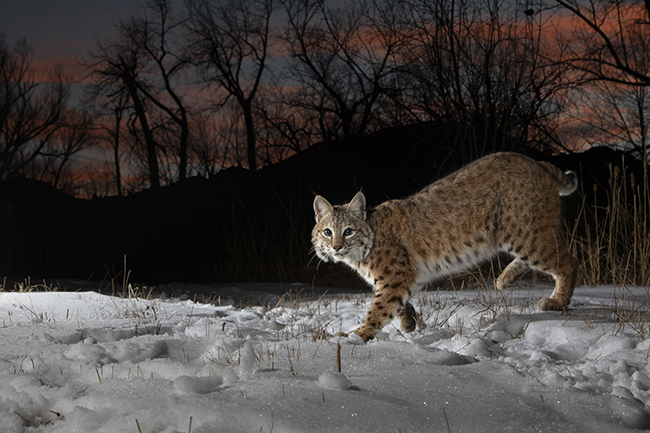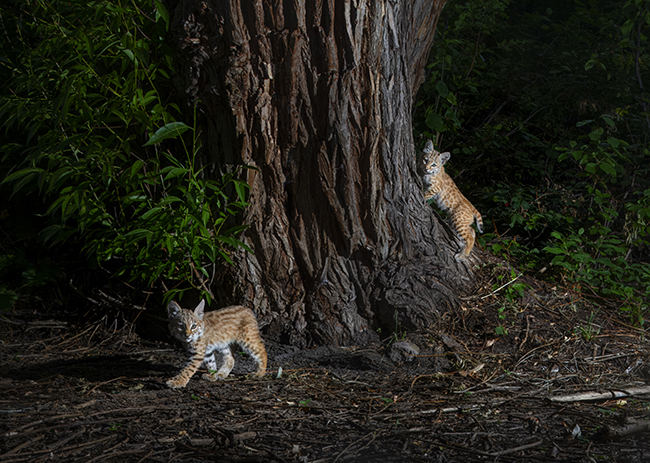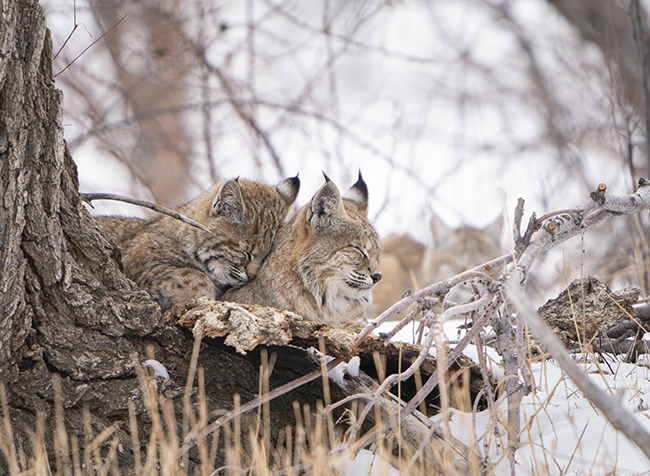Big Cats on the Ballot
03 Oct 2024
Both sides argue for conservation in Colorado’s big cat hunting debate
By Lisa Truesdale

In an already heated election season, Colorado voters will be asked to decide an emotionally charged animal-rights issue when filling out their ballots ahead of November 5: the future of the hunting of big cats in the state.
Proposition 127, spearheaded by a statewide coalition called Cats Aren’t Trophies (CATs), qualified to appear on the ballot after CATs volunteers gathered more than enough signatures (188,000) from registered Colorado voters. Prop 127 seeks to ban the trophy hunting of mountain lions, bobcats and lynx, with “trophy hunting” defined as the hunting of wild animals for “sport” and not for food, with body parts often kept for display only and the meat abandoned. (Lynx are already protected by state law but are included because they can be mistaken for bobcats, and they are often caught unintentionally in cage traps meant for bobcats.)
As with many ballot measures, Prop 127 has elicited strong responses on both sides of the issue, with a flurry of accusations flying. Remarkably, though, proponents and opponents do have something very important in common—they both believe their positions are firmly grounded in protecting the big cats.
Supporters want hunters to simply stop terrorizing and killing the majestic animals, while opponents maintain that regulated hunting keeps all wildlife populations in social and ecological balance, thereby protecting each species.
“There is no scientific reason to hunt or trap these big cats, and the hunting methods used are unethical, unsporting and repulsive,” says Christine Capaldo, DVM, a Telluride-based veterinarian who has a special interest in domestic and wild feline medicine and has trained at a number of wildlife sanctuaries. “These native wild cats are slow reproducers, they self-regulate their populations and they will not overpopulate if they’re not hunted.”

Patt Dorsey couldn’t disagree more. “The wildlife populations we have on the landscape today are no accident,” says Dorsey, the director of conservation operations, Mountain West, for the National Wild Turkey Foundation. “Hunting is crucial for keeping wildlife populations in social and ecological balance,” and that includes the hunting of
big cats.
The need (or not) for a ban
As for needing a ban on trophy hunting, Dorsey maintains it’s completely unnecessary; it’s already illegal in Colorado to take only the head, fur, antlers, etc. of an animal and abandon the meat. Passing this measure, Dorsey believes, would only serve to undermine the authority of Colorado Parks and Wildlife (CPW). “Wildlife management is nuanced and complex. Wildlife managers need flexibility, and taking away this tool is counterproductive.” (CPW is obligated to remain neutral in political issues like proposed ballot measures and was not contacted for input here.)
Erik Molvar, executive director of Western Watersheds Project, is an avid elk hunter in support of the ban. “I hunt to fill the freezer,” he says. “Shooting an animal out of a tree is not even real hunting. It’s thrill killing, and it has no place in legitimate sporting traditions.”
Dorsey disagrees with this too, explaining that hunting big cats doesn’t fall under the definition of trophy hunting, since hunters of mountain lions are required to prepare the meat for human consumption, “and the meat is very good.” Proponents of the ban argue that most mountain lion meat is exported rather than consumed locally. However, opponents contend that this assertion is misleading, pointing out that Colorado has previously outlawed the sale of big game.
Mountain lions and other big cats are apex predators—predators at the top of the food chain with no natural predators themselves. Several studies have shown that, unlike human hunters, they selectively prey on deer and elk infected with chronic wasting disease, thus helping to keep the herds healthier. “I want the elk to be healthy so the meat I eat is high quality,” says Brett Ochs, another Colorado elk hunter in support of the ban. “The middle carnivores also do their part in controlling rodents and birds, and in carrion cleanup. Carnivores are not our competition.”

Dogs chasing cats
Hunters pay $8,000 or more for an outfitter—many of whom boast of a nearly 100% success rate—to take them on guided hunts. These hunts start with a pack of trained dogs fitted with GPS collars; they flush out the cat and chase it through the forest while the hunter waits nearby. Eventually the cat tires out and climbs a tree, and then the hunter moves in to shoot the animal out of the tree with a gun or bow. It’s a practice that has been called “unsporting,” “unethical,” “repulsive” and “like shooting fish in a barrel” by supporters of the ban. “It’s a barbaric, antiquated practice that never should have started in the first place,” says Molvar.
That’s nonsense, according to Dorsey: “Hunts for big cats are often long, unsuccessful and physically challenging, just like other hunts.”
Dorsey also disagrees with Molvar on the use of dogs. She says the use of hounds can prevent mountain lions from returning to densely populated areas, and that the information from the GPS collars helps wildlife experts with their research.
Luke Wiedel, the lead policy volunteer for the Rocky Mountain Elk Foundation, is opposed to the ban and agrees with Dorsey here. “Humans and dogs evolved as hunting partners, as every pheasant and quail hunter know,” he says. “Using hounds to track and tree lions provides hunters the chance to evaluate the age, sex and reproductive status of a lion and is a common hunting technique.” That way, he explains, hunters can avoid killing an adult female. Orphaned mountain lion cubs may not yet have the skills to survive in the wild; they haven’t learned to hunt successfully and might head to lower elevations, threatening pets, livestock and humans.
A referendum on the future of hunting?
Both sides agree on one other point—that passing the ban, or not, could have an unwanted chain-reaction effect on the future of all hunting in Colorado.
Dorsey maintains that the wording of Prop 127 is a big issue. It defines “trophy hunting” as “intentionally killing, wounding or entrapping a mountain lion, bobcat or lynx, or discharging or releasing any deadly weapon at a mountain lion.” This, she explains, is misleading and ambiguous, so she doesn’t believe we should attempt to define the term “trophy hunting” in the law. If we define the hunting of any species as trophy hunting, she reasons, it will open the door to adding more species in the future. “This could eventually erode all hunting opportunities, which are a foundation of who we are as Coloradans.”
Wiedel is just as worried about the future of hunting; he predicts that, based on the organizations that are pushing the ban, especially DC-based ones, it could lead to more attacks on hunting in the state. “Their goal is to end all human hunting for wild meat,” he believes.
Not surprisingly, Molvar has the opposite take; he says that not passing the ban is what could eventually lead to the end of hunting in Colorado. “When you have a type of hunting that violates ethics and looks unfair to the public, that actually becomes a threat to other types of hunting,” he explains. If the “indefensible” practice of hunting big cats is allowed to continue, “it makes all hunters look bad.”
The Mountain Lion Foundation, based in California but involved in every state that has a breeding population of the big cats, is confident that the ban, if passed, would have an incredible impact in Colorado. A similar ban was passed by voters in California in 1990, and the big cats there have not overpopulated, and the deer and elk populations have not decreased dramatically.
“Hunting mountain lions is one of the forms of hunting the public least approves of, right up there with the unpopular hunting of elephants and African lions,” says Paige Munson, the foundation’s science and policy coordinator. “As we move forward in a world of declining biodiversity, habitat loss and climate change, efforts such as the Colorado ballot measure to protect wild cats and conserve species in closer accordance with their role in the ecological system are a step in the right direction.”












